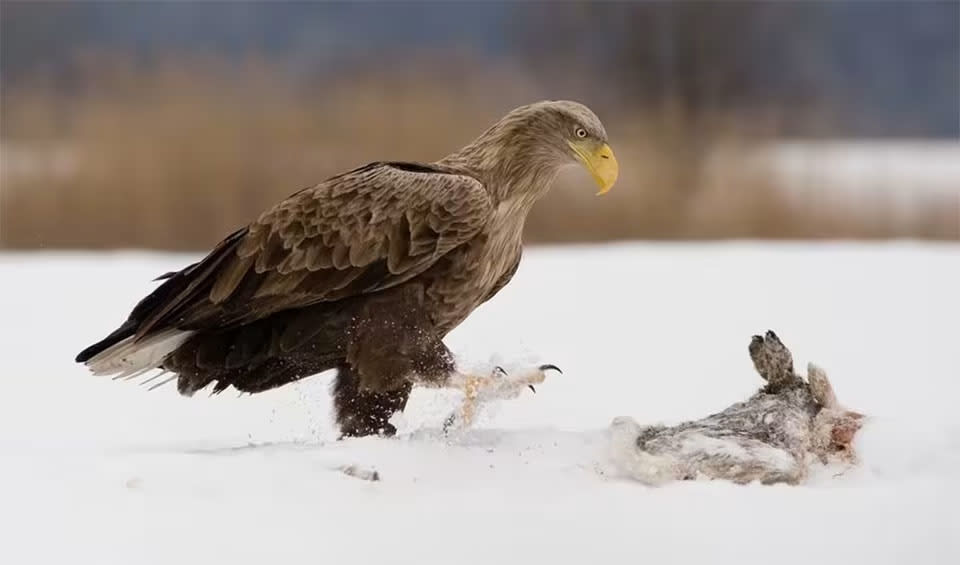Often revered as the “sea eagle,” it is a majestic bird of prey that has made a remarkable comeback from the brink of regional extinction. With conservation efforts leading to successful reintroduction in the 20th century, these raptors have reclaimed their place in the skies of the British Isles, Western Europe, the Faeroes, and certain Mediterranean areas where they had previously vanished.
These large eagles are identified by their broad wingspan, which can reach up to 2.5 meters (8.2 feet), and their notable white tail contrasting with their brown body plumage. As one of the largest eagle species, they command the coastal environments, large lakes, and rivers where they reside, serving as apex predators within their ecosystems.
White-tailed eagles exhibit lifelong monogamy, forming strong pair bonds crucial for cooperative breeding and survival. In the unfortunate event of a partner’s death, however, they display a pragmatic approach to finding new mates, ensuring the continuation of their lineage.
The diet of white-tailed eagles is varied, reflecting their adaptability as opportunistic feeders. Their notoriety for taking farm animals has been historically exaggerated, but they are known to feed on a range of prey, including fish, waterfowl, and carrion. Far from being the ‘pirates’ they were once accused of being, these eagles often clean up dead fish and offal, playing a vital role in their ecological communities.
Distribution
 Afghanistan
Afghanistan Albania
Albania Algeria
Algeria Official estimate
Official estimate
 Armenia
Armenia Austria
Austria Azerbaijan
Azerbaijan Bangladesh
Bangladesh Belarus
Belarus Belgium
Belgium Bhutan
Bhutan Bosnia And Herz.
Bosnia And Herz. Bulgaria
Bulgaria China
China Croatia
Croatia Cyprus
Cyprus Czechia
Czechia Denmark
Denmark Egypt
Egypt Estonia
Estonia Faroe Islands
Faroe Islands Finland
Finland France
France Georgia
Georgia Germany
Germany Official estimate
Official estimate
 Greece
Greece Greenland
Greenland Hungary
Hungary Iceland
Iceland India
India Iran
Iran Iraq
Iraq Ireland
Ireland Israel
Israel Italy
Italy Japan
Japan Kazakhstan
Kazakhstan Korea
Korea Kyrgyzstan
Kyrgyzstan Latvia
Latvia Lebanon
Lebanon Lithuania
Lithuania Luxembourg
Luxembourg Malta
Malta Moldova
Moldova Mongolia
Mongolia Montenegro
Montenegro Myanmar
Myanmar Nepal
Nepal Netherlands
Netherlands North Korea
North Korea North Macedonia
North Macedonia Norway
Norway Official estimate
Official estimate
 Pakistan
Pakistan Poland
Poland Official estimate
Official estimate
 Portugal
Portugal Official estimate
Official estimate
 Romania
Romania Russia
Russia Saudi Arabia
Saudi Arabia Serbia
Serbia Slovakia
Slovakia Slovenia
Slovenia Spain
Spain Spain
Spain Svalbard
Svalbard Sweden
Sweden Official estimate
Official estimate
 Switzerland
Switzerland Syria
Syria Taiwan
Taiwan Tajikistan
Tajikistan Thailand
Thailand Tunisia
Tunisia Turkey
Turkey Official estimate
Official estimate
 Turkmenistan
Turkmenistan Ukraine
Ukraine United Kingdom
United Kingdom United States
United States Uzbekistan
UzbekistanAnything we've missed?
Help us improve this page by suggesting edits. Glory never dies!
Suggest an editGet to know me
Terrestrial / Aquatic
Altricial / Precocial
Polygamous / Monogamous
Dimorphic (size) / Monomorphic
Active: Diurnal / Nocturnal
Social behavior: Solitary / Pack / Herd
Diet: Carnivore / Herbivore / Omnivore / Piscivorous / Insectivore
Migratory: Yes / No
Domesticated: Yes / No
Dangerous: Yes / No




